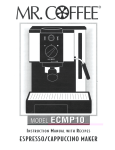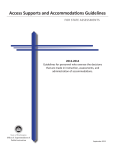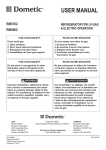Download Wiley Laptops For Dummies, 4th Edition
Transcript
Chapter 1 AL The Portable Computing Quest In This Chapter RI ▶ Understanding portable computing ▶ Reviewing laptop history TE ▶ Recognizing the Tablet PC variation ▶ Getting to know the netbook D I MA ▶ Deciding whether you need a laptop GH TE figure, sometime a long time ago, one early proto-nerd had an idea. Wearing his thick glasses and a white lab coat, he stared at the large, vacuum tube monster he was tending. He wondered what it would be like to put wheels on the six-ton beast. What if they could wheel it outside and work in the sun? It was a crazy idea, yet it was the spark of a desire. PY RI Today that spark has flared into a full-blown portable computing industry. The result is the laptop, Tablet PC, or netbook computer you have in your lap, or which your lap is longing for. It’s been a long road — this chapter tells you about the journey by explaining the history of the portable computing quest. CO Laptop History You can’t make something portable simply by bolting a handle to it. Sure, it pleases the marketing folk who understand that portability is a desirable trait: Put a handle on that 25-pound microwave oven and it’s suddenly “portable.” You could put a handle on a hippopotamus and call it portable, but the thing already has legs, so what’s the point? My point is that true portability implies that a gizmo has at least these three characteristics: ✓ Lightweight ✓ No power cord ✓ Practical 8 Part I: The Laptop Shall Set You Free The ancient portable computer Long before people marveled over (solar powered) credit-card-size calculators, there existed the world’s first portable, human-powered calculator. Presenting the abacus, the device used for centuries by merchants and goatherds to rapidly perform calculations that would otherwise cause painful headaches. Abacus comes from the Greek word meaning “to swindle you faster.” Seriously, the abacus, or counting board, is simple to master. Many kids now learn to use the abacus in elementary school. In the deft hands of an expert, an abacus can perform all the same operations as a calculator — including square and cubic roots. In his short story Into the Comet, science fiction author Arthur C. Clarke wrote of stranded astronauts using many abacuses to plot their voyage home when the spaceship’s computer wouldn’t work because the Internet was down and their version of Windows couldn’t be validated. In the history of the portable computer, those three things didn’t happen all at once, and definitely not in that order. The Xerox Dynabook The desire to take a computer on the road has been around a long, long time. Back around 1970, long before the notion of the personal computer existed, Xerox PARC developed the Dynabook concept. Today, you’d recognize the Dynabook as an e-book reader, very similar to the Amazon Kindle: The Dynabook was to be the size of a sheet of paper and only a half-inch thick. The top part was a screen; the bottom, a keyboard. Chapter 1: The Portable Computing Quest The Dynabook never left the lab, remaining only a dream. Yet the desire to take a computer on the road wouldn’t go away. For the next three decades after the Dynabook concept, many attempts were made to create truly portable computers. The Osborne 1 The first successful portable computer was the Osborne 1, created by computer book author and publisher Adam Osborne in 1980. Adam believed that in order for personal computers to be successful, they would have to be portable. His design for the Osborne 1 portable computer was ambitious for the time: The thing would have to fit under an airline seat — and this was years before anyone would even dream of using a computer on an airplane. The Osborne 1 portable computer (see Figure 1-1) was a whopping success. It featured a full-size keyboard and two 51⁄4-inch floppy drives but only a teensy, credit-card-size monitor. It wasn’t battery powered, but it did have a handy carrying handle so that you could lug around the 24-pound beast like an overpacked suitcase. Despite its shortcomings, 10,000 units a month were sold; for $1,795, you got the computer plus free software. Figure 1-1: A late-model Osborne. 9 10 Part I: The Laptop Shall Set You Free The loveable luggables The Osborne computer was barely portable. Face it: The thing was a suitcase! Imagine hauling the 24-pound Osborne across Chicago’s O’Hare airport. Worse: Imagine the joy expressed by your fellow seatmates as you try to wedge the thing beneath the seat in front of you. Computer users yearned for portability. They wanted to believe the advertising images of carefree people toting the Osborne around — people with arms of equal length. But no hip marketing term could mask the ungainly nature of the Osborne: Portable? Transportable? Wispy? Nope. Credit some wag in the computer press for dreaming up the term luggable to describe the new and popular category of portable computers ushered in by the Osborne. Never mind its weight. Never mind that most luggable computers never ventured from the desktops they were first set up on — luggables were the best the computer industry could offer an audience wanting a portable computer. In the end, it wasn’t the Osborne computer’s weight that doomed it. No, what killed the Osborne was that in the early 1980s the world wanted IBM PC compatibility. The Osborne lacked that. Instead, the upstart Texas company Compaq introduced luggability to the IBM world with the Compaq 1, shown in Figure 1-2. Figure 1-2: The luggable Compaq 1. Chapter 1: The Portable Computing Quest The Compaq 1, introduced in 1983 at $3,590, proved that you could have your IBM compatibility and haul it on the road with you — as long as a power socket was handy and you had good upper-body strength. Yet the power cord can stretch only so far. It became painfully obvious that for a computer to be truly portable — as Adam Osborne intended — it would have to lose that power cord. The Model 100 The first computer that even remotely looks like a modern laptop, and was fully battery powered, was the Radio Shack Model 100, shown in Figure 1-3. It was an overwhelming success. The Model 100 wasn’t designed to be IBM PC compatible, which is surprising considering that PC compatibility was all the rage at the time. Instead, this model offered users a full-size, full-action keyboard, plus an eensie, 8-row, 40-column LCD text display. It came with several built-in programs, including a text editor (word processor), a communications program, a scheduler, and an appointment book, plus the BASIC programming language, which allowed users to create their own programs or buy and use BASIC programs written by others. Figure 1-3: The Radio Shack Model 100. 11 12 Part I: The Laptop Shall Set You Free Portability and communications Long before the Internet came around, one thing that was deemed necessary on all portable computers was the ability to communicate. A portable computer had two communications duties. First, it had to be able to talk with a desktop computer, to exchange and update files. Second, it needed a modem to be able to communicate electronically over phone lines. Nearly every portable computer, from the Radio Shack Model 100 onward, required a modem, or at least an option for installing one. This was before the Internet era, back when a modem was considered an optional luxury for a desktop computer. Out on the road, away from a desktop at the office, early proto-road-warriors needed that modem in order to keep in touch. The Radio Shack Model 100 was all that was needed for portability at the time, which is why the device was so popular. ✓ The Model 100 provided the form factor for laptops of the future. It was about the size of a hardback novel. It ran for hours on standard AA batteries. And, it weighed just 6 pounds. ✓ So popular was the Model 100 among journalists that it was common to hear the hollow sound of typing on its keyboard during presidential news conferences in the 1980s. ✓ Despite its popularity and versatility, people wanted a version of the Model 100 that would run the same software as the IBM PC. Technology wasn’t ready to shrink the PC’s hardware to Model 100 size in 1983, but the Model 100 set the goal for what people wanted in a laptop’s dimensions. The lunch buckets Before the dawn of the first true laptop, some ugly mutations slouched in, along with a few rejects from various mad scientists around the globe. I call them the lunch bucket computers because they assumed the shape, size, and weight of a typical hard-hat’s lunch box. The Compaq III, shown in Figure 1-4, was typical of this type of portable computer. ✓ The lunch box beasts weighed anywhere from 12 to 20 pounds or more, and most weren’t battery powered. ✓ The lunch bucket portables were the first PCs to use full-screen LCD monitors. (The Osborne and Compaq portables used glass CRTs.) Chapter 1: The Portable Computing Quest Figure 1-4: The Compaq III. ✓ Incidentally, around the same time as the lunch bucket computers became popular, color monitors were becoming standard items for desktop PCs. All portables at the time, even those with LCD monitors, were monochrome. ✓ Honestly, the lunch buckets did offer something over the old transportable or luggables: less weight! A late-model lunch bucket PC weighed in at about 12 pounds, half the weight and about one-eighth the size of the suitcase-size luggables. Dawn of the PC laptop The computer industry’s dream was to have a portable computer that had all the power and features of a desktop computer yet was about the same size and weight as the Model 100. One of the first computers to approach that mark was the Compaq SLT, back in 1988, as shown in Figure 1-5. The Compaq SLT was the first portable computer that resembles one of today’s laptops: A hinged lid swings up and back from the base, which contains the keyboard. This design is known as the clamshell. 13 14 Part I: The Laptop Shall Set You Free Figure 1-5: The Compaq SLT. Feature-wise, the SLT had what most PC desktop users wanted in a portable system: a full-size keyboard, full-size screen, floppy drive, and 286 microprocessor, which meant that the computer could run the then-popular DOS operating system. The computer lacked a hard drive. Weight? Alas, the SLT was a bowling ball, at 14 pounds! What the Compaq SLT did was prove to the world that portability was possible. A laptop computer was designed to feature everything a desktop computer could, plus run on batteries for an hour or so. Yeah, believe it or not, people were delighted. The search for light Just because the marketing department labeled the computer a “laptop” didn’t mean that it was sleek and lightweight. For a while there, it seemed like anyone could get away with calling a portable PC a laptop, despite the computer’s weight of up to 20 pounds — which is enough to crush any lap, not to mention kneecaps. Chapter 1: The Portable Computing Quest Calculating laptop weight: The missing pieces When computer companies specify the weights of their laptops, I’m certain that they do it under ideal conditions, possibly on the moon or at some other location where gravity is weak. The advertised weight is, as they say, “for comparison purposes only.” Commonly left out of the laptop’s weight specs is the power brick, the AC adapter used to connect the laptop to a wall socket. When the laptop isn’t running on batteries, you need the power brick to supply the thing with juice, so the power brick is a required accessory — something you have to tote with you if you plan to take the laptop on an extended trip. In the old days, what they didn’t tell you in the advertisements was that the power brick often weighed half as much as the laptop itself! Either that or the power brick was even bulkier than the laptop, as shown in the figure, in the obnoxiously big Dell 320LT power brick (and its heavy 30-minute batteries). Lugging around those items isn’t convenient. Things are better today. In the fall of 1989, NEC showed that it could think outside the laptop box when it introduced the UltraLite laptop, shown in Figure 1-6. The UltraLite featured a full-size screen and keyboard but no disk drives or other moving parts! It used battery-backed-up memory to serve as a silicon disk. The silicon disk stored 1 or 2MB of data — which was plenty back in those days. 15 16 Part I: The Laptop Shall Set You Free Figure 1-6: The NEC UltraLite. As was required of all laptops, the UltraLite featured a modem, and it could talk with a desktop computer by using a special cable. Included with the UltraLite was software that would let it easily exchange files and programs with a desktop PC. The weight? Yes, the UltraLite lived up to its name and weighed in at just under 5 pounds — a feather compared to the obese laptops of the day. And, the battery lasted a whopping two hours, thanks mostly to the UltraLite’s lack of moving parts. The modern laptop As technology careened headlong into the 1990s, it became apparent that users were desperate for three things from their laptop computers — in addition to the basic PC compatibility, portability, and communications features that were long ago deemed must-haves. ✓ Light weight ✓ Long battery life ✓ Full hardware compatibility with desktop systems Chapter 1: The Portable Computing Quest Over time, all these qualities were achieved — at a price. Today, the holy grail of a lightweight, PC-compatible laptop that boasts a long battery life isn’t elusive; it’s just expensive! ✓ Weight: Depending on how much you want to pay, your laptop can be anywhere from a half-inch thick to just under an inch thick and weigh between 2 to 6 pounds. The weight and size also depend on the features you want in your laptop, with more features adding more weight. ✓ Battery life: Although the batteries themselves haven’t improved much in the past several years, thanks to power-management hardware and software, modern laptops can extend battery life from the once-standard two hours to about three or four hours. ✓ Hardware compatibility: Since the late 1990s, all laptops come with color screens, just like desktop systems do. Most also sport optical drives (CD or DVD), just like desktops do. Laptops feature modems, networking (wired and wireless) capabilities, and expansion options. Special laptop processors and other types of hardware have been developed over the years, keeping laptop hardware small and energy efficient. The Tablet PC Computer manufacturers have long attempted to create the electronic equivalent of a pencil and pad of paper — a very expensive pencil and pad of paper. Basically, what they’re after is a portable computer with a monitor but no keyboard. Data is input by using a digital stylus to write directly on the screen. Over the years, this digital triptych has had various names attached to it: the PenGo computer, the Apple Newton, Pen Windows, and eventually the Tablet PC. The Tablet PC began life a few years back as its own computer category. The machine was about the same size as a laptop, but it didn’t fold open; the monitor was “face up” all the time. That model failed miserably. The Tablet PC now exists as a laptop hybrid: The machine can be used like any other laptop, but the display can be pivoted and laid flat over the keyboard, as shown in Figure 1-7. The result is a flexible computer system that is a laptop with Tablet PC features. 17 18 Part I: The Laptop Shall Set You Free Figure 1-7: A Tablet PC. ✓ Even as a hybrid, Tablet PC sales haven’t taken off. Apparently, writing on the screen isn’t a feature that laptop users are eager to use. ✓ Tablet PCs are discussed throughout this book and specifically in Chapter 8. ✓ The ancients used something called a tabulae ceratea to write temporary messages. Every Greek or Roman schoolboy took with him to class a folding wooden tablet. The insides were coated with a black wax. Using a stylus (basically a stick), the student would write into the wax, again and again. Oh, we’ve truly come such a long way. The netbook Human laps aren’t getting any smaller. Human eyes can only comfortably read text that’s so big. Most important, human fingers have trouble with keyboards that are too tiny. Despite these limitations, the most recent step in laptop evolution is the netbook, which is the smallest, lightest, and most portable computer. The netbook is not powerful and not truly a complete desktop replacement. It lacks an optical drive, for instance, and most of them lack the computing horsepower to run some advanced programs. What they do provide, however, is an inexpensive and highly portable platform for using the Internet, accessing e-mail, and performing simple tasks, such as word processing. Figure 1-8 illustrates a typical netbook computer, the ideal laptop system for students or anyone who’s on the go and doesn’t need the bulk or power of a full-size laptop computer. Chapter 1: The Portable Computing Quest Figure 1-8: The eensyweensy netbook PC. 19 20 Part I: The Laptop Shall Set You Free Portable gizmos galore! Portable computing means more than just a laptop and, of course, a laptop computer is more than just a portable PC. So what is a laptop and what’s not? The laptop itself can be described by its size. Lighter laptops have been dubbed notebook computers, though that term appears to be more of a marketing phenomena than any official laptop category. The netbook is an ultralight, mobile laptop of limited power. Tablet PCs are traditional laptops that let you write on the screen by using an electronic stylus. Some Tablet PCs don’t even have traditional computer keyboards. Beyond the laptop you find a host of portable computing devices, many of which are geared toward specific needs. For example, an e-book reader gizmo isn’t a full-on computer, but instead uses its computer power to let you read electronically published books, magazines, newspaper articles, and even browser the Web just about anywhere. Also added to the mix is the typical smartphone, which is a cellphone capable of accessing the Internet, storing and managing information, running special programs (or apps), playing music, taking pictures or shooting video, and doing a host of other wondrous things. Some people predict that all these gizmos may one day be consolidated into a single device. Only time will tell. The laptop of the future I don’t believe that the laptop computer will supplant the typical desktop computer system. Though more and more people are opting to replace their older desktops with laptops, there’s still a need for desktop power that can’t be had in a portable computing device. One item still on the laptop wish list is battery technology. Today’s laptops last longer on battery power than the laptops of ten years ago. Then again, going from 2 hours on battery power to 31⁄2 hours isn’t really the improvement that people want. The solution for battery power in the future is something called the fuel cell, which acts like a miniature power plant directly connected to your laptop PC. Fuel cell technology promises power that lasts for weeks instead of hours, which will prove a boon to portable gizmos of every kind — but only when the fuel cell makes sense economically. Although fuel cells are available now, they’re just too expensive and bulky for laptops. Supposedly, the first fuel-cell-powered laptops will be here soon, but “soon” is still far enough in the future to be anyone’s guess. Until then, laptop users will have to slug it out with rechargeable batteries and power packs. Chapter 1: The Portable Computing Quest See Chapter 10 for more information on batteries and other power-management issues. Do You Need a Laptop? The journey is over. You have arrived. Adam Osborne’s dream is here: Portable computers are everywhere. As a consumer, and as someone who needs a computer in order to survive in the 21st century, the question is simple: Do you need a laptop? Why you need a laptop I can think of several reasons for getting a laptop computer: Have a laptop as your main computer Why dither over saving money with a desktop when you really want the portability of a laptop? A desktop computer cannot pretend to be a laptop, but a laptop can certainly fake being a desktop: You can use a full-size keyboard and monitor with your laptop. You can also connect any number of popular desktop peripherals, such as a printer, a scanner, or an external hard drive. The advantage is, unlike with a desktop system, you’re free to disconnect the laptop and wander the world whenever you want. Use a laptop as a space-saving computer system Unlike with desktops, you don’t have to build a tabletop shrine to your laptop computer — that is, you don’t need a computer desk. If space is tight where you live or work, keep the laptop on the shelf or in a drawer. Then set it up on the kitchen table or coffee table whenever you’re ready to work. Forget about the constant mess and clutter that orbit the typical desktop computer station. Viva Adam Osborne! Get a laptop as a second computer Why buy a second desktop computer when you can get a laptop and enjoy not only the presence of a second computer but also the ability to make that computer system portable? Furthermore, you can network the two computers, allowing them to share the Internet connection and printers as well as each other’s data and files. And, you still have the luxury of having one system that’s portable. 21 22 Part I: The Laptop Shall Set You Free Mr. Laptop Goes to College Setting up a computer in a college dorm room in the 1980s was the sure sign of being a nerd. Today, not setting up a laptop computer in a college dorm room is the sure sign of being a social outcast. I implore future students to pester their parental units early, say, starting in the seventh grade, to ensure that they leave for college armed with the best portable computing power possible. No, I’m not being silly. Some colleges require students to arrive with a laptop in tow. Those Institutions may even publish laptop guides so that campus compatibility is guaranteed and issues such as viruses and spyware are dealt with before classes start. My advice: Follow those guidelines. Look for a laptop based on the school’s recommendations. But there’s still more you need to do. Be sure to prepare a college-bound laptop for the onslaught of malware. See Chapter 17 for vital information about laptop security. Also see Chapter 21 for dealing with another college laptop issue: theft. You’ve probably spent a lot of time preparing for college; you should prepare the laptop for college as well. Take the laptop on the road Laptops let you take your work on the road. After a few moments of synching (transferring current files between your desktop and laptop, covered in Chapter 19), you’re off and running to anywhere you like (although being in direct sunlight can make it difficult to see the laptop screen). When you return from your “road warrior” trip, you perform another synch and both computers get all caught up for the day. ✓ Laptops let you escape the confines of your office and do work anywhere you like for a few hours. Or, if there’s power at your location, you can plug in and work all day. ✓ The laptop lets you take your work with you when you travel. It lets you experience the reality of using a computer on an airplane (which isn’t as cool as it sounds). Why you don’t need a laptop Laptops aren’t cheap. They’re also expensive to fix. Forget about upgrading the hardware. They can easily get stolen. The battery life never lives up to the printed specifications. It’s tough to get work done on a jet or in a café because people either look over your shoulder or ask you questions about the laptop. Ack! But those are minor quibbles. Thanks to their light weight, long battery life, and increasing computing power, laptops make ideal computers for just about anyone. If you don’t own a laptop now, you will someday.

























